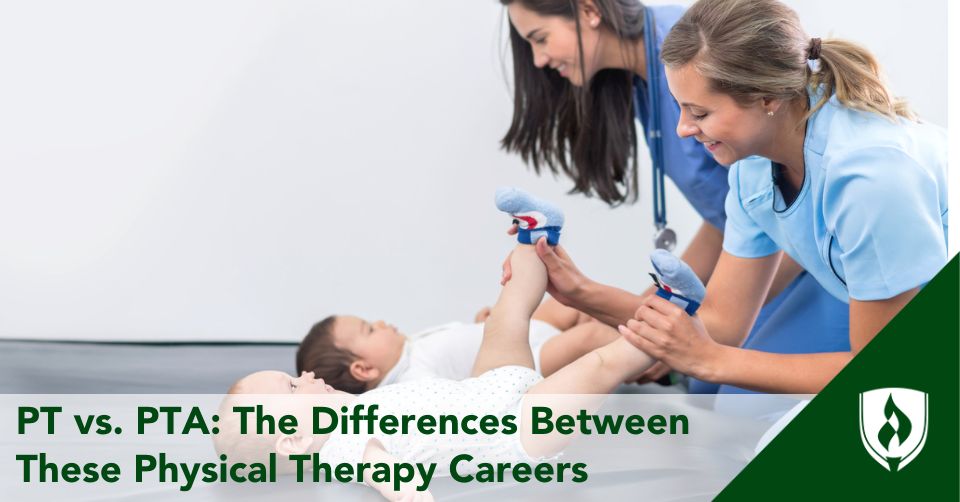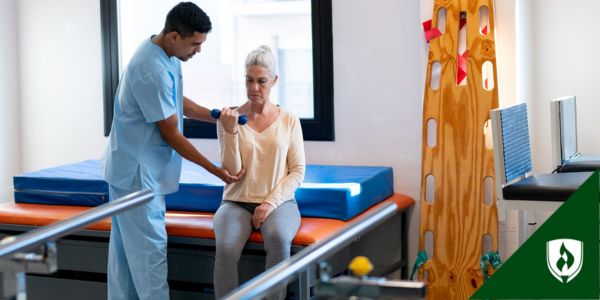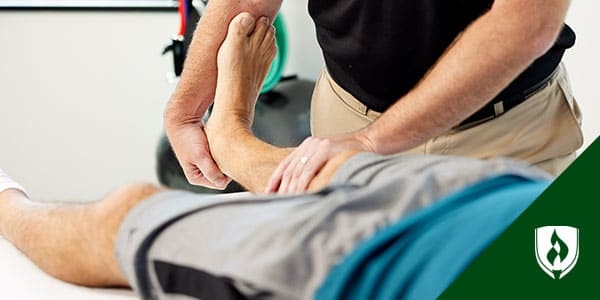
When it comes to career paths in modern healthcare, physical therapy roles may be among the most rewarding. Physical therapy directly impacts a patient’s quality of life. People turn to physical therapists (PTs) for a myriad of health concerns: everything from sprains and breaks to arthritis and the aftermath of strokes. Physical therapy helps patients to improve mobility and reduce pain; therefore, it can have a significant impact on overall wellness.
Of course, physical therapists don’t work alone—at least, not most of the time. They have assistants who work closely with them and also provide hands-on care to patients. But, don’t get it twisted: Physical therapist assistants (PTAs) don’t have the same level of training as PTs. In fact, their education requirements and day-to-day responsibilities are dramatically different. Nonetheless, both PTs and PTAs have important roles in their patients’ care. Rasmussen University does not offer any programs that will lead to the career opportunity of Physical Therapist
So, if you’re looking for a thorough breakdown of these two roles, then you’re in the right place! Just keep reading.
PT vs. PTA: Job duties
PTs and PTAs both play key roles in their patients’ treatment plans. But while they may even share some core duties, there’s a big difference between the role of a physical therapist vs. that of a physical therapist assistant.
The role of physical therapists
A licensed physical therapist is a healthcare professional who works with patients who need help managing pain and/or improving mobility. Physical therapists “are often an important part of preventive care, rehabilitation, and treatment for patients with chronic conditions, illnesses, or injuries,” according to the Bureau of Labor Statistics (BLS).1
For example, PTs work with patients who need help regaining their mobility after a traumatic brain injury—or managing chronic pain. After an initial evaluation, physical therapists develop a treatment plan to help their patients adapt and heal. They can also help with injury prevention.
Because people of all ages and from all walks of life can require treatment, physical therapists develop individualized care plans for their patients. These plans factor in each patient’s medical history and may also account for referrals provided by other medical professionals.1
Generally, a care plan will include some combination of exercises, stretches, massage and equipment, such as canes, crutches, wheelchairs and walkers, the BLS explains.1 PTs use their discretion to determine the most appropriate therapies for each patient’s unique needs.
The role of physical therapist assistants
As you might expect, a physical therapist assistant works under the supervision of a PT.
Physical therapist assistant is one role the PT team, along with a physical therapy technician (also called physical therapy aide). But PTAs have a greater hand in working with patients than techs do.
Essentially, the licensed physical therapist delegates tasks to the PTA. And this brings us to one of the key differences between a PT and a PTA: While a PTA may perform hands-on therapy and guide patients through their exercises, only a licensed physical therapist has the credentials to create patients’ care plans.1,2
As the American Physical Therapy Association states, “When the physical therapist utilizes a physical therapist assistant, …collaboration… between the physical therapist and physical therapist assistant is essential.”3 In other words, the role of a PTA is to work collaboratively with—and under the leadership of—a licensed PT.
So, what does a physical therapist assistant’s job consist of? Actually, quite a lot! As the Bureau of Labor Statistics explains, PTAs have the following duties:
- Observing patients before, during and after physical therapy
- Taking note of each patient’s status and reporting this to the physical therapist
- Guiding patients through the specific exercises that comprise each care plan
- Providing hands-on therapy techniques, such as massages and stretches
- Helping patients use devices and equipment (like walkers, for example)
- Educating patients and their family members about what to do after physical therapy treatment2
PT vs. PTA: Where they work
Since a physical therapist assistant works under the supervision of a licensed PT, you probably won’t find PTAs working any place that doesn’t also employ physical therapists. Here’s a quick breakdown of the largest employers for each role, per the Bureau of Labor Statistics:
Physical therapists
- Offices of physical, occupational and speech therapists, and audiologists
- Hospitals
- Home healthcare services
- Nursing and residential care facilities
- Self-employed workers4
Physical therapist assistants
- Offices of physical, occupational and speech therapists, and audiologists
- Hospitals
- Home healthcare services
- Nursing care facilities (skilled nursing facilities)
- Offices of physicians5
Continuing the similarities, most PTs and PTAs work full-time schedules, although part-time schedules are also common in both types of physical therapy roles. It’s also worth noting that, as a physical therapist or a physical therapist assistant, you might find yourself working during evenings and/or weekends to accommodate patients with busy schedules.4,5
Both jobs also require you to spend most of your time on your feet. Moving and lifting patients also comes with the territory in each role.4,5
PT vs. PTA: Job outlook
Whether you’re leaning towards becoming a physical therapist or a physical therapist assistant, good news! Both of careers show promising demand, in terms of job outlook. This is, in large part, due to the aging baby boomer generation.6,7 “Older people are more likely to experience heart attacks, strokes, and mobility-related injuries that require physical therapy for rehabilitation,” the Bureau of Labor Statistics explains.7
Physical therapists
Physical therapist roles are projected to increase by 15 percent between 2022 and 2032, which is “much faster than the average for all occupations,” according to the BLS. This translates to roughly 13,900 openings for physical therapists each year, on average, over the decade.7
Physical therapist assistants
Physical therapist assistant roles are projected to grow even faster than their PT counterparts, at 26 percent, from 2022 to 2023, based on BLS reports.6
More specifically PTs rely upon PTAs “in long-term care environments, in order to reduce the cost of physical therapy services”.6 According to BLS this should help assist with employment growth of PTAs.6
PT vs. PTA: Education requirements
Education requirements couldn’t be more different for these two career paths in physical therapy. Assistant roles don’t require nearly as much schooling as PT positions—that’s a plus for anyone who wants to pursue a career in patient care.
Physical therapists
A physical therapist needs a Doctor of Physical Therapy (DPT) degree—among other credentials—to practice. Before you can apply for a DPT program, however, you’ll need to complete a bachelor’s degree in a related field.8
DPT programs commonly take three years to complete, whereas most bachelor’s degree programs translate to four years of studying. That means students who want to become PTs can generally expect to spend at least seven years in school before they’re able to do so.8
DPT programs usually consist of coursework that covers biomechanics, neuroscience and pharmacology. In addition, students pursuing this doctorate degree must typically complete clinical rotations to gain experience in areas like acute and orthopedic care, the BLS explains.8
Aside from completing a Doctor of Physical Therapy degree, all states require prospective PTs to obtain licensure. Naturally, specific licensure requirements vary from one state to the next. It is important to check with your state board for specific licensing requirements.
Still, passing the National Physical Therapy Examination administered by the Federation of State Boards of Physical Therapy (FSBPT®) is required in every state.8
Physical therapist assistants
Compared to becoming a licensed PT, the path to becoming a physical therapist assistant is much shorter. First, you’ll need an associate’s degree from a program accredited by the Commission on Accreditation in Physical Therapy Education®.9 Check with your state board for specific licensing requirements
As the BLS mentions, most associate’s degree programs in physical therapy include courses on subjects like anatomy, physiology and kinesiology. Students should also expect to complete clinical rotations.9
Furthermore, every state requires PTAs to be licensed or certified. So, in addition to completing associate’s degree programs, learners will need to follow their states’ specific licensing requirements. And every state also requires PTAs to pass the National Physical Therapy Exam for physical therapy assistants, which is administered by the Federation of State Boards of Physical Therapy (FSBPT®).9
PT vs. PTA: Which career path can you see yourself in?
Now that you know the difference between a physical therapist and a physical therapist assistant, you’ve probably started to think about which role makes the most sense for you. Working in physical therapy can be extremely rewarding for anyone who has an interest in exercise and wants to provide care to people in need.
A Doctor of Physical Therapy program may be worth looking into if you’ve already earned your bachelor’s degree. And, if not, Rasmussen University’s Physical Therapist Associate’s degree program can prepare you to enter the field in as few as 18 months.10
Learn more about how you can blend online classes with on-campus labs as a Physical Therapist Assistant student at Rasmussen.
FSBPT® is a registered trademark of Federation of State Boards of Physical Therapy
Rasmussen University does not offer any programs that will lead to the career opportunity of Physical Therapist.
1Bureau of Labor Statistics, U.S. Department of Labor, Occupational Outlook Handbook, Physical Therapists, (accessed May 2024), https://www.bls.gov/ooh/healthcare/physical-therapists.htm#tab-2
2Bureau of Labor Statistics, U.S. Department of Labor, Occupational Outlook Handbook, Physical Therapist Assistants and Aides, (accessed May 2024), https://www.bls.gov/ooh/healthcare/physical-therapist-assistants-and-aides.htm#tab-2
3American Physical Therapy Association, Direction And Supervision Of The Physical Therapist Assistant, (accessed May 2024), https://www.apta.org/apta-and-you/leadership-and-governance/policies/direction-supervision-pta
4Bureau of Labor Statistics, U.S. Department of Labor, Occupational Outlook Handbook, Physical Therapists, (accessed May 2024), https://www.bls.gov/ooh/healthcare/physical-therapists.htm#tab-3
5Bureau of Labor Statistics, U.S. Department of Labor, Occupational Outlook Handbook, Physical Therapist Assistants and Aides, (accessed May 2024), https://www.bls.gov/ooh/healthcare/physical-therapist-assistants-and-aides.htm#tab-3
6Bureau of Labor Statistics, U.S. Department of Labor, Occupational Outlook Handbook, Physical Therapist Assistants and Aides, (accessed May 2024), https://www.bls.gov/ooh/healthcare/physical-therapist-assistants-and-aides.htm#tab-6
7Bureau of Labor Statistics, U.S. Department of Labor, Occupational Outlook Handbook, Physical Therapists, (accessed May 2024), https://www.bls.gov/ooh/healthcare/physical-therapists.htm#tab-6
8Bureau of Labor Statistics, U.S. Department of Labor, Occupational Outlook Handbook, Physical Therapists, (accessed May 2024), https://www.bls.gov/ooh/healthcare/physical-therapists.htm#tab-4
9Bureau of Labor Statistics, U.S. Department of Labor, Occupational Outlook Handbook, Physical Therapist Assistants and Aides, (accessed May 2024), https://www.bls.gov/ooh/healthcare/physical-therapist-assistants-and-aides.htm#tab-4
10Completion time is dependent on transfer credits accepted and the number of courses completed each term.




